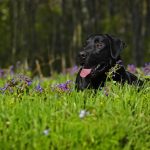A little bit of extra time at the beginning and end – of training, exercise, hunting, or play – can maximize performance and prevent injury.
by Jason Smith

Photo by Chip Laughton: www.daysafieldphotography.com
Every athlete warms up. Layups, long toss, jogging, stretching, batting cage, skating… the key to succeeding in sports is, frankly, being there to participate in the game. And you can’t participate if you’re injured. And you’ll get injured if you don’t warm up.
We know this.
Yet even though we recognize our dogs are, at their core, athletes, we too often – maybe always – get them out of the crate or the car, strap on their collar, and go. No warmup other than their potty breaks to mark trees, and their quivering with excitement at the activity to come – hunting, swimming, or a frolic in the park.
“I definitely think the most common and most potentially detrimental is the ‘zero-to-sixty method,’ i.e., going from crate or car to full, uncontrolled athletic activity,” says Dr. Jimi Cook, a veterinary orthopedic surgeon and sports medicine specialist at the University of Missouri. At a Purina Sporting Dog Summit I attended last year, Dr. Cook spoke passionately to the need for both warming up and cooling down for maximizing your dog’s performance and the effectiveness of your training and conditioning program, and for preventing injury.
“Lack of warmup is so common, and I do understand why; but we have to make people aware of how potentially problematic this is and really work hard to get warmups to be a non-negotiable habit. Cooldown is critical, too, but I think that is a more natural thing for dogs to do and owners to include, consciously or subconsciously – and also a bit less problematic if not done as well.”
A lot happens during structured warmups and cooldowns. In addition to the psychological benefits of getting your dog on the same page with you – which pays fantastic dividends whatever it is you’re doing, since a dog that is “synched” with you will listen, respond, and learn better – you are prepping the dog’s body for a workout. We tend to think in terms of how long we are out there hunting and how far we walked, but it’s not anywhere near the workout compared with what our dogs do. Just strap a GPS collar on your dog and watch his track.
“We want to increase muscle temperature before performance/work and bring it down to baseline before completely stopping performance/work,” says Dr. Cook. “Physiologically, the warmup works even down to the molecular level to ‘prepare’ the muscles, tendons, bloodflow, and even nerves for higher level function. This increases performance but also helps decrease risk for injury because the tissues are ‘ready,’ if you will, for the higher demands of performance/work.
“Cooldown helps the tissues not go into ‘shock’ after high level use – slowly bringing them back down to baseline helps remove the byproducts of muscle energy use, like lactic acid; lets the cells recover their hydration and electrolyte balances; and lets the tissues go back into normal mode – again minimizing risk of soreness, cramps, etc.”
The age of the dog and the weather also play a role in how you approach these periods. “Just as the older we get the more we need to warm up and cool down for athletic activities, the same holds true for our dogs. Weekend warrior injuries, like Achilles tears, are definitely more common and more severe when no warmup or active stretching is done. And cooler weather will require a bit longer period to get muscle temperatures up to performance levels.”
Warmup
Photo by Chip Laughton: www.daysafieldphotography.comAs I said, flitting around exploring and peeing is not a warmup. Neither is just running from the car to the first objective in the field or park, or jumping up and down waiting for the bumper or ball.
“An effective warm-up regimen is pretty easy to incorporate,” says Dr. Cook. “It involves ten to fifteen minutes of submaximal, activity-specific exercise. What does that mean? It means you want the dog doing things that are similar to what he will do during performance/work, but at a lower intensity level. To me, the most effective way to cover all the bases on this is to do large figure-eights on a hill using a long lead or Flexi lead. Start these at a walk for three-five minutes, then at a trot for three-five minutes, then tighten the circles at a trot for three-five minutes. If your dog needs to jump for performance/work, you can add small jumps – four-six inches – into this routine as well. Think about how any elite human athlete warms up in today’s world – basketball, football, baseball, track, soccer. They all do submaximal, activity-specific activities right up until game time. It is the best way to increase performance and decrease injury risk.”
This type of submaximal, activity-specific warmup is a type of “active stretching.” “Active stretching is stretching the muscles, tendons, and other soft tissues involved in function by having the dog do activities that increase joints’ ranges of motion rather than the owner just putting the joints through an increased range of motion themselves,” Dr. Cook explains. “The figure-eights on a hill help do this.”
You might think that a 15-minute warmup would tire out the dog. But I haven’t seen LeBron James poop out in the first quarter because of pre-game shoot-arounds. “It’s a great question,” Dr. Cook, says, “but no, they will not just be getting tired. Remember, it is submaximal activity, and only ten to fifteen minutes. They will actually have more energy and stamina if done correctly.”
Staying hydrated is also critical, but getting your dog out of the car is a difficult time to get him to drink. A warm-up regimen around the car, prior to setting out, might provide an opportunity for the dog’s heart to get beating a little faster and allow for a small drink. “You want to make sure the dog stays hydrated – so access to water or water-plus-Powerade or similar is good. But you don’t want them to drink too much – access to small amounts is good. There are also some effective ‘power bars’ for dogs, which can be good before warmup as well – just try them out in a training setting some time to make sure your dog does okay with them.”
If for whatever reason you can’t perform the warmup at the place where you will be working, you might be able to complete this critical step at home before loading up, provided you don’t have too far to drive. “The general rule of thumb is about thirty minutes,” Dr. Cook says of the time between completing warmup and beginning the activity without losing the benefits of the warmup.
Cooldown

Photo by Chip Laughton: daysafieldphotography.com
When the day is done, cooling down in the crate or the car isn’t the best idea. So much more emphasis these days – in human athletics and workout programs – is being placed on the cool-down phase. I know, for me, nothing tightens me up more after a (cough… rare… cough) workout than just stopping and moving on to the rest of my evening. Cooling down with slow, thorough stretching does wonders for helping me get out of bed the next day.
“Cooldown is basically warmup in reverse; however, the activity-specific part is not as critical,” Dr. Cook says. “An effective cooldown can just be a ten to fifteen minute walk after performance/work. A lot of dogs will still be pretty hyped up after performance/work, so trotting for the first five minutes or so is fine, and then gradually calm them down to a nice walk for at least five minutes. The main thing is just to avoid going from performance/work to crate or even the bed.”
If we’re upland hunting, many times we’ll finish out the cover at the far end and have a trail to walk back to the vehicle. Dr. Cook says this is good enough for a cooldown, “as long as the last five minutes are at a controlled walking pace.” You might want to put a leash in your coat to make sure the dog isn’t romping and jumping – and hunting – his way back. The gradual slowdown is best.
The main part of the cooldown, of course, is hydration, and it usually isn’t a problem getting our dogs to drink at this point. “We want to get the dog rehydrated and allow for cell and tissue recovery,” Dr. Cook says, “so pretty much free access to water and or water-plus-Powerade is needed.” As with pre-work nutrition, there are also some post-work, “recovery” type bars for canines that may or may not work for your particular dog. “The dog can and should have its food as soon as desired after cooled down,” Dr. Cook finishes.
The anticipation of the hunt or play can cloud judgment – both human and canine. It’s such an exciting time, and in a day and age when time is at such a premium, we don’t want to waste a minute. It seems we either have time to perform the activity, or we don’t have the time to do anything with the dog at the moment. So it’s common to overlook these critical periods.
“I think it [neglecting warmups and cooldowns] is probably a combination of a lack of awareness about their importance and benefits and how to do them, along with a feeling that there isn’t enough time for these during the limited periods for training and working dogs.” This can come back to bite our dogs in a big way if this 0-60 method – and, also, 60-0 – as Dr. Cook says, is our normal procedure.
We spend so much time and energy and angst discovering ways to get the most out of our dogs, helping them overcome bumps and bruises, and striving to prevent injury. Consider the extra half-hour – 15 minutes for warming up, and 15 minutes for cooling down – as part of the time you have for your activity, and budget for these crucial phases for our canine athletes. You don’t want them sitting on the bench.
Related Articles
Dr. James L. Cook, DVM, PhD, DACVS, DACVSMR, University of Missouri: After receiving his undergraduate degree from Florida State University and competing for five years as a professional water skier, Dr. Cook completed his DVM in 1994 and Ph.D. in 1998, both at the University of Missouri. In 1999, he founded the Comparative Orthopaedic Laboratory. He has more than 160 publications, over $20 million in research funding, received numerous awards including America’s Best Veterinarian (2007), holds 14 U.S. patents, and has seen three biomedical devices through FDA approval to human clinical trials.
After 18 years as a veterinary orthopaedic surgeon in the College of Veterinary Medicine, he came to the Missouri Orthopaedic Institute to head the Division of Research as the William and Kathryn Allen Distinguished Professor in Orthopaedic Surgery. Dr. Cook and his wife, Cristi, also a veterinarian, have two dogs and three cats; do puppy raising for New Horizons Service Dogs; and run Be The Change Volunteers, a NGO dedicated to building schools in developing villages whose teams have built 27 educational facilities in 15 countries, providing educational opportunities to more than 5,000 students.





